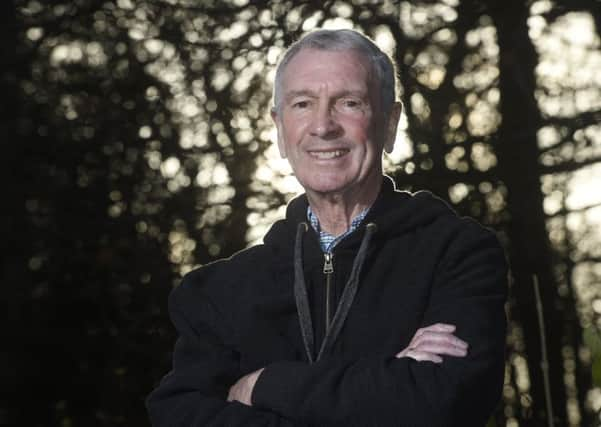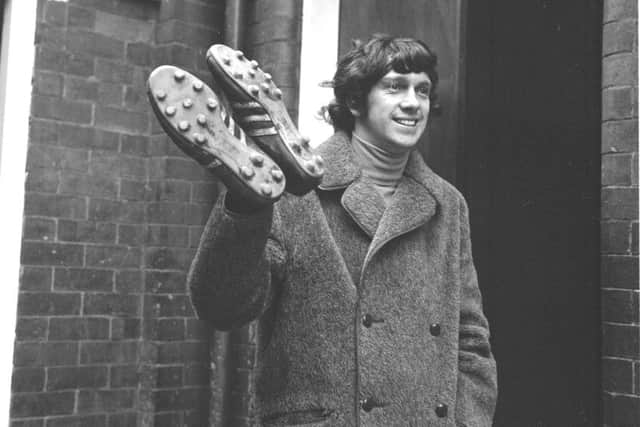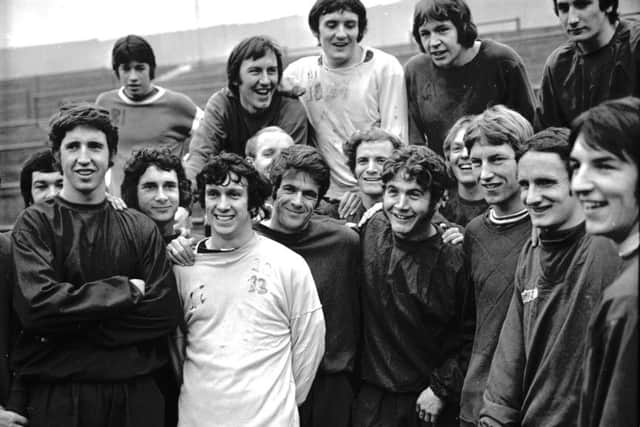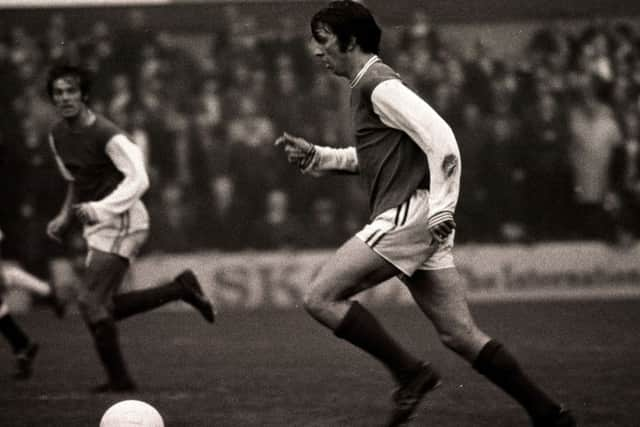Interview: Eric Stevenson on his love affair with Hibs


What do you do when your fate rests on the results of a scan? “You wait and you wait and you think to yourself: ‘Well I’ve had a good time in my life,’” says the man who was Hibernian’s left winger right through the 1960s. “Some of the guys who were in hospital at the same time as me weren’t so fortunate but I got lucky. When the test came back the specialist said: ‘You’re smiling.’ My wife Agnes, who had cancer herself four years ago, said: ‘As long as he’s still smiling in two minutes’ time.’ The doc said: ‘I think he will be.’”
Because of chemotherapy and an operation to remove his stomach, Stevenson, 73, was too weak to be at Hampden for Hibs’ great Scottish Cup triumph in May and so watched the final on TV. Two-one down to Rangers with only ten minutes remaining, the prognosis wasn’t good. “But that was a terrific comeback. In my time at Hibs the cup – not winning it – wasn’t such a big deal. But recently it was driving the fans mad. I was born a Hibby and will be one to my dying day. I’m just glad that day was delayed long enough for me to see them win the trophy. When the final whistle went Agnes and I danced round the living room in floods of tears.”
Advertisement
Hide AdAdvertisement
Hide AdStevenson can be excused his non-attendance because in 1972, when Hibs beat Celtic to lift the League Cup, he sneaked on to the Mount Florida slopes when he should have been with his new Ayr United team-mates. “Although I wasn’t going to be playing for Ayr that day [manager] Ally MacLeod would have wanted me at their game. But I was desperate to see Hibs win something. I’d played in the 1969 final and scored the last goal – unfortunately Celtic hammered us 6-2. I got to Hampden nice and early and the lads spotted me during the warm-ups and gave me a wave. Maybe Jock Stein saw this and clyped on me! I’d played with Ally at Hibs but he told me he’d have to fine me two weeks’ wages. It was well worth it.”


The Hibees of ’72 were Turnbull’s Tornadoes and Stevenson would have loved to have been part of that fine side. Catching up with his old mates, they’d tell him how they missed his elusive wing-play and that he could have been sharing in their success. But others reported gloomily that Easter Road had turned into a “prison camp” under Turnbull’s disciplinarian rule. There was little scope for his elusive off-the-field behaviour. “I enjoyed the social side of football,” he says. “Maybe I enjoyed it too much because there were times when I’d go missing. Eddie weeded out the slackers and I was one of them.”
We’re talking at his home in Dalkeith, Midlothian with its fine views over the River Esk. The back garden is dotted with play equipment, although the kids have given Grandpa the morning off. The previous night at Easter Road was the launch of his memoirs and five Tornadoes – John Blackley, John Brownlie, Alex Cropley, Jimmy O’Rourke and Pat Stanton – lined up with Peter Cormack, Bobby Duncan, Neil Martin, Jim Scott and others to celebrate the lost art of dribbling and eulogise their old chum who, everyone was agreed, was one of the best Scots never to be capped, and certainly the best flank-hugger sporting a Tony Curtis quiff.
The 1960s, in football as in society, was a time of newfangledness and wackiness and Stevenson fitted right in. One innovation was the five-a-side tournament at Murrayfield Ice Rink at the decade’s end, organised by Leith Round Table and sponsored by Uniroyal, which was won by a Hibee quintet led by our man. At the party, while there was consensus that Cropley had smashed a goal against Hearts from halfway, direct from a ref’s drop-ball, some remembered the Edinburgh rivals having been thumped 9-1, others by as many as 11.
Stevenson performed on stirring European nights against Napoli, Valencia, Leeds United and Liverpool. In a green shirt with white sleeves he played in the nearly-teams managed by Jock Stein and Bob Shankly. One Scottish League XI appearance seems scant reward for a born entertainer, who helped the Hibees get to 11 against Alloa Athletic and Hamilton Accies, and, in a derby, score two of the four they netted in the first ten minutes.


But, you know, he could have been a Jambo. Hearts were first to spot the teenager’s flair and he got to train with two of the Terrible Trio in the autumn of their careers as well as Gordon Smith who’d crossed the city divide. He signed a form, unaware this was a full professional contract. It would have to be kept in manager Tommy Walker’s drawer until he was old enough, but the SFA got wind of the ruse and fined the club and the boss.
“I was ignorant of the whole situation but it dragged on for a while, during which I wasn’t allowed to play for anyone else,” he says. “This was a running story in the papers and I was dubbed ‘The Rebel’ until thankfully Hibs came to the rescue. They even reimbursed me for money I was going to have to pay back to Hearts, whose fans saw me as having rejected their club. That lot never forgave me and running down the wing in derbies in front of the enclosure at Tynecastle I always got some choice abuse!”
Stevenson rejected Manchester United to join his heroes and, while he would see Cormack, Joe Baker, Colin Stein and Peter Marinello leave Leith for more money and greater glamour, he never hankered after a move. “I was playing for Hibs and thought I’d be there for ever,” he says, adding that he enjoyed the celebrity of being a footballer. “Walker’s at the West End was the best place for dancing. I didn’t have to queue to get in.” He was a homebird but could this have been partly explained by his dramatic, drifting start in life? He agrees it could.
Advertisement
Hide AdAdvertisement
Hide AdIn the South Lanarkshire mining village of Eastfield, Stevenson’s mother Christine gave birth to him on Christmas Day, 1942, while the man she intended to marry was fighting the Second World War – but he was not the father. Christine’s fiance, and eventual husband, didn’t reject Stevenson on his return – “He was good to me” – but domestic arrangements still proved tricky and the boy was sent to live with his grandparents, only for his gran to pass away. “I was on the move again, this time to my mum’s sister Nan and her husband Tam who everyone called Elk.


“I went along with all of this, didn’t think it was unusual. These days I suppose a boy in these circumstances would be fussed over with all sorts of agencies involved. Do you know that aged nine I was put on various buses to travel alone from Bonnyrigg to Eastfield to visit my mum? That wouldn’t happen now. I used to get sick on those journeys and the conductor would let me ride holding on the pole at the back so I could get some fresh air. That wouldn’t happen now either!
“By the way, I didn’t know I was visiting the woman who was my real mother. I wasn’t told the whole story until later. I’ve never met my biological father and, I have to admit, haven’t really been curious about him. I was well looked after by Nan and Elk. They had a son, Henry, who also played football and who I regarded as my big brother. Of all the games I played in my life I treasure the one time we were on opposite sides the most, even if it was just the reserves and Dunfermline battered us 6-1.
“Everyone got along just grand. Later, I used to drive Nan and her sister – my mum – to the bingo. The family arrangement bounced along in its funny way and I don’t think it did me any harm. There was maybe only one incident that bothered me. At school the teacher said, ‘Eric Clark – stand up’, because that was my adoptive parents’ surname and I didn’t realise he was addressing me. That was embarrassing but I survived.” And before too long an entire, chanting throng would know his name.
It was the man called Elk – “He didn’t have big antlers or anything” – who instilled a love of Hibs in Stevenson, founding the Bonnyrigg branch of the supporters’ club during the Famous Five’s pomp when his job as a coal miner brought the family east. Stevenson journeyed home and away to watch Willie Ormond beetle down the left wing, a gig he’d soon inherit.


“He was some man was Elk. Before I signed for Hibs he stipulated that I got to travel abroad with the team at the earliest opportunity. That turned out to be Barcelona.” Although he didn’t play in a classic encounter immortalised in song, Stevenson and Jim Scott were treated to a night on the Ramblas by Ormond who, even though he was supposed to be chaperoning them, had to be helped back to the hotel by the youngsters in the wee small hours. Now Stevenson is laughing; that makes it two future Scotland managers he outdrank. “When Hibs played Belenenses in Lisbon we hit the town with Ally MacLeod. Like Willie, Ally was a lovely guy but a couple and he was away.”
Stevenson blames the coal-mining culture for an early introduction to the booze. He had a brief stint at the old Lady Victoria pit in Newtongrange when “jug bars” would serve colliery apprentices as young as 15. “You were working underground so you were viewed as an adult. My pals and I would have a couple of wee heavies en route to the dancing in Rosewell.”
If all miners drank, he reckons, then so did all footballers. “It’s hard to think of one who didn’t apart from Peter [Cormack]. We were working-class lads. Some were good trainers, though, and I wasn’t. When I quit playing my head was away because my first marriage had fallen apart but the high life had caught up with me as well. I never thought football would end for me but it did.”
Advertisement
Hide AdAdvertisement
Hide AdMaybe that devil-may-care attitude, while ultimately self-limiting if not destructive, informed his football. Perhaps, he says, but there was good career advice around if he’d bothered to listen. “Neily [Martin] got picked for Scotland’s [1965] World Cup qualifier against Italy so [Hibs goalie] Willie Wilson and I went through to Hampden to cheer him on. We gave a lift to Jock Wallace, then manager of Berwick Rangers, who said to me: ‘Stevie, you need a kick up the f****n’ arse. You could be playing in this game tonight – the potential you have is incredible. But you have too much nonsense in your head and are aye out socialising.’ I said: ‘I know, Jock, I’ll have to get a grip.’ But a minute later I was asking: ‘Shall we stop at Whitburn for a couple of pints?’”
When he was in the mood, Stevenson was too tricky for some full-backs and won his team a lot of penalties. The previous night another old Hibee, John Fraser, told how Stevenson earned a cup-tie spot-kick at Dens Park from “Tiny” Wharton but when he claimed another in a league match at the same venue a few weeks later, the larger-than-life ref quipped: “Not today, Swan Lake.” “Was I a diver? Listen, I played against Bobby Shearer, Eric Caldow, Kai Johansen, wee Willie Cockburn, John Lambie and Tommy Millar of Dundee United. If I’d tried to con these guys they would have got me back the next challenge and I wouldn’t have wanted that.”
As he continues his recovery from surgery, Stevenson is looking forward to the day when he can eat a steak again, also go for a decent walk. Before his Easter Road debut, he elected to walk the mile-and-a-half from the team’s rendezvous to the ground and this became his ritual. He first tasted steak in Belgrade, away to Red Star. “It was beautiful but too rare for John Grant – the Duke – so I said: ‘Pass yours here.’ This surprised the lads. I’d been dead shy when I joined Hibs – maybe that was because of my start in life – but knew I could play and on that trip I came out of my shell. ‘If you were down a pit with a jam piece like I was a year ago,’ I said, ‘then you’d be very thankful for this meal.’”


The free-form nature of football in the 1960s threw up a number of oddities for Stevenson such as a head-tennis tournament in Manchester where he and Marinello representing Hibs fell foul of local rules. “We were only allowed two touches. The way we did it at Easter Road you could have as many as you liked.” He played in a game where the opposition goalie – for Dutch side Maastricht – wore glasses throughout. He played in another where his pal Willie Wilson became an emergency winger after injury meant he couldn’t continue in goals, teasing Stevenson afterwards about the role being dead easy.
Continental football, and there was lots of it for Hibs, increased the strangeness even more. In the former Czechoslovakia, a match was interrupted by a bicycle race. Sunbathing in Rome he got badly sunburned and Eddie Turnbull’s vinegar remedy only increased the agony. On an often torrid North American tour, first Derek Dougan threatened to lead Wolves off the pitch and then Cagliari did exactly that. Then came the African expedition of 1968: “That was pretty scary. The planes were antiquated, the thunderstorms were terrifying. And in Nigeria, where there was civil war, Colin Stein and I got mistaken for mercenary paratroopers.
“But the games were great fun. I was playing keepy-uppy before the first one which got the crowd excited so I proceeded to show off the whole tour. The locals got very excited, jumped up and down and shouted things I couldn’t understand. Honest, it was just like playing in front of the Tynecastle enclosure!”
l Hibs Through and Through: the Eric Stevenson Story is published by Luath Press (£12.99).